The fight over abortion is a war without end because it has always been conducted at extremes. The Alito doctrine resolves none of that because, assuming Roe v. Wade is overturned on his terms, the justice has only moved the issue from one extreme to the other.
For the 50 years since the Supreme Court ruling in 1973, the law of the land has permitted abortion up to the point of “viability”, defined as when the fetus can survive on its own outside the womb, set at 23 weeks of pregnancy. This is the left-wing extreme position which says that up to that point it isn’t really a human, so it’s okay to destroy it. Before that, not quite ready to go forth umbilically untethered, so disposable. It’s true that few abortions occur that late, but demanding the absolute freedom of “my body, my choice” for the full 23 weeks without regard to that second life is abhorrent. What if the viability standard were applied to those helplessly intubated with COVID, or to the old in nursing homes who cannot manage unaided. Just let ’em go? The pro-choice absolutists fear they cannot compromise because the pro-lifers never will.
The pro-lifers at the other extreme insist a human is formed at the moment of conception when sperm penetrates egg. Or earlier. Listen to what the fervidly religious Mike Pence said — and in a campaign debate, no less,
“The sanctity of life proceeds out of the belief [in] that ancient principle where God says ‘before you were formed in the womb I knew you.'”
You didn’t know it but your pregnancy was God’s plan. This is where the fanaticism of religion takes over and words such as “sacred” are invoked. It is the moment at which a cluster of cells becomes “ensouled” with no regard to what is actually happening physically in a woman’s body. The absolutist pro-lifers cannot be dislodged by knowledge. Unyielding and unquestioning for its coming from religion, their contention that a human is created at the moment of fertilization is a obduracy that admits of no compromise, which guarantees the feud between the two camps has no prospect of resolution.
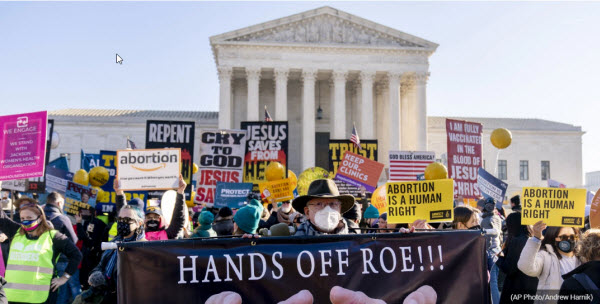
On the left, so many articles and editorials refer to abortion as “women’s health care” as if no other life is involved so as to duck the sordid business. And every time out it is referred to as a woman’s “constitutional right”. It is nowhere in the Constitution. Is this gaslighting their effort to make us think a Supreme Court ruling makes it constitutional?
The debate is never settled because, as Michael Gazzaniga writes in “The Ethical Brain, ““[m]oral arguments get mixed in with biology, and the result is a stew of passions, beliefs, and stubborn, illogical opinion.” On 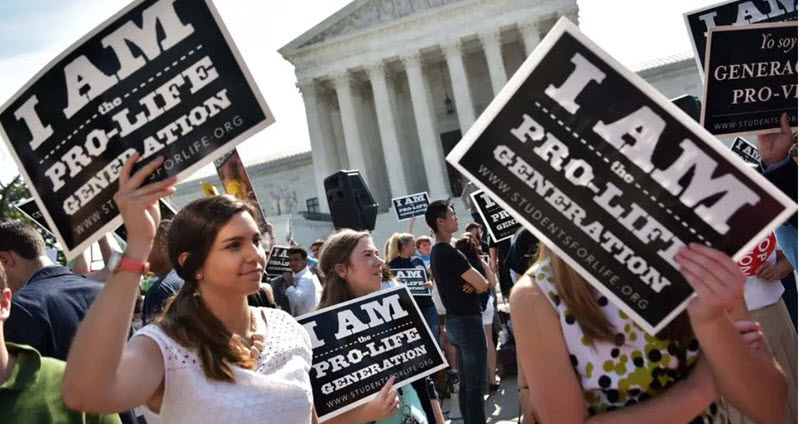
the right, a refusal to accept the science: Peggy Noonan, columnist at The Wall Street Journal, says, “I am pro-life for the most essential reason: That’s a baby in there.” Hold on. Not for a while after conception. Ross Douthat, the conservative columnist at The New York Times who often writes from a Catholic point of view, says in an article titled “The Case Against Abortion” that
“[W]e now know the embryo is not merely a cell with potential, like a sperm or ovum, or a constituent part of human tissue, like a skin cell. Rather, a distinct human organism comes into existence at conception.”
No it does not.
Three weeks into pregnancy, the zygote – one cell each from egg and sperm joined as a single cell – measures 0.1 millimeters, too small to see. After the first month, the embryo’s bundle of undifferentiated cells is still smaller than a grain of rice. At the end of the second month, when the embryo begins to be called the fetus, it is only an inch long. By the end of weeks nine through twelve, the fetus has taken on human form, but not right off. Remember, it was only an inch at the outset of week nine. So, weeks nine and ten might still qualify as the fetus being an instruction set for a human but not yet a human.
Women have valid reasons for wanting to end a pregnancy. Apart from the obvious revulsion of having to carry and then care for the product of rape or incest, pregnancy and caring for a child can be economically disastrous for a single woman or a wife whose income is vital. But in the preceding paragraph, we presented a 10-week window during which reasonable persons could agree that abortion does not end what could persuasively be considered a true human being.
But, goes the argument, a woman can go weeks without knowing she is pregnant, tightly narrowing the proposed window, or running past it to find she is too late. Answer: if having sex, test for pregnancy weekly. Pregnancy tests are cheap and reliable. Those on the left need to yield and take some responsibility other than insisting on doing whatever they please for the full 23 weeks.
If the offering could be made that abortion be restricted to the first 10 weeks, it could be a forceful argument against the unreasonableness of the religious fanatics who are entirely free not to abort but have no right dictating their religion or illogic to others.
THE EXTREME ALITO DOCTRINE
That won’t change the mind of Samuel Alito, who is on a crusade to make America a theocracy, having ruled on the side of religious plaintiffs in every case. And voting along with him on the right end of the bench — a worry for those who fear related cases will be overturned — are four more Catholics and a fifth who was raised and schooled as a Catholic before becoming Episcopal.
The Alito opinion does not consider the real-world effects of ending Roe v. Wade. His document is interested only in arguing that the 50-year-old precedent is constitutionally invalid, and it took him 98 pages to do so. “Roe was egregiously wrong from the start”, he writes with considerable arrogance given that he is faulting five justices in the 7-to-2 Roe decision who were appointed by Republican presidents. Three of the current Court’s right-wing majority were appointed by a president who lost the popular vote, two of them by the shadiest of tactics. As a Times opinion piece put it, you’d think that “might counsel a modicum of moderation and humility”. Not from Alito, who said, “We cannot allow our decisions to be affected by any extraneous influences such as concern about the public’s reaction to our work”. He said the same in his confirmation hearing in 2005. We were warned. According to Gallup, 81% of extraneous Americans think abortion should not be outlawed entirely.
Alito’s opinion does not ban abortion. It says, “It is time to heed the Constitution and return the issue of abortion to the people’s elected representatives”. The matter will be returned to the states, which satisfies the conservative desire that the nation be split into 50 different satrapies with the chaos of 50 sets of laws. Abortion will be banned by 26 states that have trigger laws on their books that take effect the moment Roe is overturned.
Lawrence O’Donnell (MSNBC) is dumbfounded by this. We will become…
“a country where your rights depend on where you live. Other countries of the world do not understand this. They do not understand why a fundamental right…depends on your address!”
Roe is hinged on a right to privacy not found in the Constitution, goes the standard objection, but there is an infinity of matters not covered in the Constitution of 214 years ago and the amendments since. Row’s right stems from Justice William O. Douglas sensing in 1965’s Griswold v. Connecticut “penumbras…emanating” from what the document does say, by which he arrived at the privacy we all should expect. That case was not about abortion, but Roe v. Wade capitalized on the right to privacy Douglas deduced.
Alito had to defeat the privacy issue of Roe. A right not explicit in the Constitution needs to be implicit in the country’s history and traditions, is his contention. He was repeating what Chief Justice William Rehnquist wrote about history and tradition in an unrelated case. On those grounds, should not Alito as well advocate reversing women’s right to vote like Prohibition? After all, women were considered not at all in the years before 1920 when the Nineteenth Amendment gave them the vote, so that enjoyed neither history nor tradition. And, despite Alito’s assurances to the contrary, that criterion has raised concern that Obergefell v. Hodges (2015) could be axed by the conservatives on the Court because same-sex marriage certainly is not rooted in the nation’s history or traditions.
After contesting Roe, Alito had to start over in his argument to defeat 1992’s Planned Parenthood v. Casey because it made no mention of privacy. Thirty years on, Casey is its own precedent — “precedent on precedent” as Brett Kavanaugh called it in his confirmation hearing. Casey instead keys on “liberty” in the Fourteenth Amendment’s “nor shall any State deprive any person of life, liberty, or property, without due process of law”. In a long series of cases the Court has recognized in the Fourteenth a number of unenumerated rights that give “constitutional protection to personal decisions relating to marriage, procreation, contraception, family relationships, child rearing, and education” in Casey‘s own words.
Alito says that for an unenumerated right to be valid under the Fourteenth, it must be “‘implicit in the concept of ordered liberty”, adding “ordered”, whatever that means, to try to encumber “liberty”. It comes across as contrivance whereas Casey‘s point about the liberty statement is powerful:
“[T]he Clause has been understood to contain a substantive component as well, one ‘barring certain government actions’…[A]ll fundamental rights comprised within the term liberty are protected by the Federal Constitution from invasion by the States…Our precedents ‘have respected the private realm of family life which the state cannot enter.'”
The Constitution specifically proscribes “establishment of religion” which has been its entire history and tradition, but this court will have no problem allowing prayer at public high school football games. We will then see it overturn precedents that allow abortion because there was no history and tradition. Confused?
May 31 2022 | Posted in
Law |
Read More »
< insurrection|30|50|>
After the 2020 election, Donald Trump won the media’s attention with incendiary claims that the election had been stolen, ultimately rousing his base to riot when Congress met to certify that Joe Biden was to be the new president. We covered that route to January 6th in Part One.
Occurring in parallel, surfacing only later, primarily from the work of 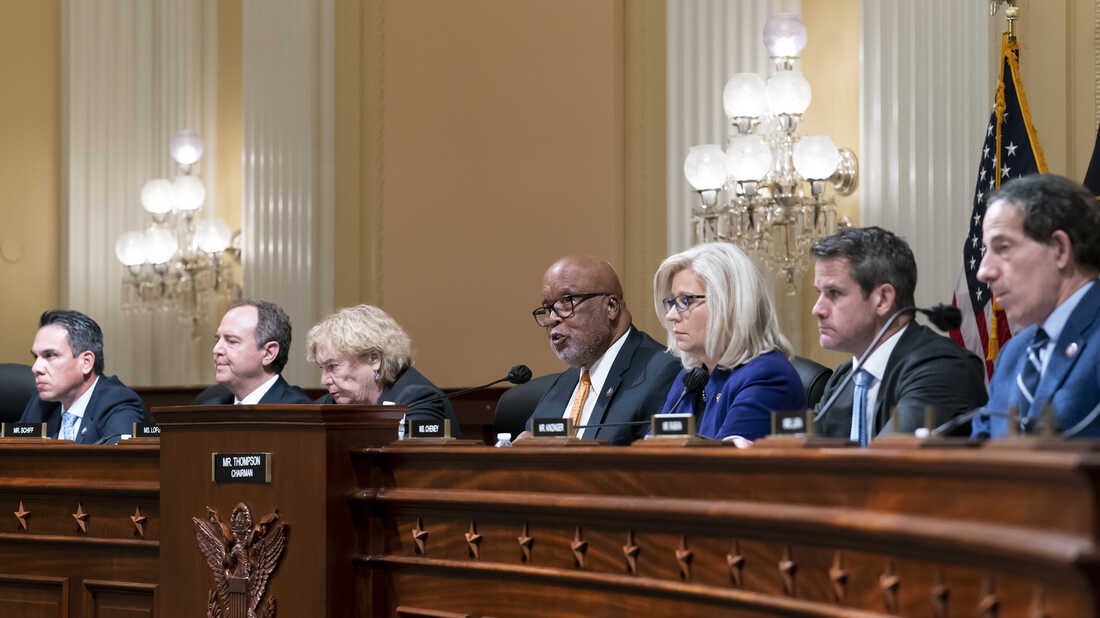
House Select Committee investigating the happenings of Jan. 6, 2021
the House Select Committee investigating everything related to January 6th, did it become apparent that Trump allies were hatching a scheme to overturn the election by disrupting the proceedings in Congress. Had the plot succeeded, it would have been an actual stolen election, this time by Trump.
THE BEST LAID PLANS…?
In the two-month span from November 3rd to January 6th, text messages, email, and tweets showed how widespread was the Republican push to keep Donald Trump in the White House.
Everyone turned to Mark Meadows as chief of staff. Energy Secretary Rick Perry texted him the day after the election with ideas for overturning the results. “We have the data driven program that can clearly show where the fraud was committed. This is the silver bullet”, he wrote.
Three days after the election, Arizona representative Andy Biggs, wary that what he proposed would be “highly controversial” to the point of referring to electors in coded sound-alike language (“a look doors”), wrote of state legislatures appointing substitute electors “in the various states where there’s been shenanigans.”
Marjorie Taylor Greene texted Meadows, “Good morning Mark, I’m here in DC. We have to get organized for the 6th…We are getting a lot of [House] members on board. And we need to lay out the best case for each state”.
Rudy Giuliani, Trump’s personal lawyer began speaking to state legislators in a quest to persuade them to reverse electoral college votes.
The media had contacted Alabama Representative Mo Brooks, who wrote to Meadows and others in a group text asking whether he should answer their questions about the “formulation of our January 6 strategies” or whether he should “be mum”.
In over a hundred text messages to Meadows after the election, Utah Senator Mike Lee and Texas Representative Chip Roy urged that Trump campaign to overturn the election. Fearing that this 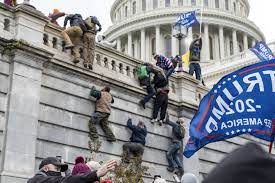
would lead to Congress deciding the presidency very four years, Roy ultimately withdrew, but Lee, a who called himself a “constitutional conservative” who had written three books on the Constitution, persisted to the end, telling Meadows he’d spent January 4th “calling state legislators for hours today.”
On January 2nd, Texas Senator Ted Cruz sent Meadows a link to a statement by him and six other senators and four senators-elect that called for a 10-day delay in certification for election results to be audited which would “dramatically improve Americans’ faith in our electoral process and would significantly enhance the legitimacy of whoever becomes our next President.”
The day before, Ohio Representative Jim Jordan decreed,
“On January 6, 2021, Vice President Mike Pence, as President of the Senate, should call [cull?] out all electoral votes that he believes are unconstitutional as no electoral votes at all — in accordance with guidance from founding father Alexander Hamilton and judicial precedence.”
The next day, after the assault on the Capitol, Wyoming’s Liz Cheney allegedly said to Jordan, “Get away from me. You f**ing did this.”
Even after January 6th, the right wing was still looking for ways to keep Trump in office. Three days before Biden’s inauguration, Ms. Greene texted Meadows…
“In our private chat with only Members, several are saying the only way to save our Republic is for Trump to call for Marshall law…They stole this election. We all know. They will destroy our country next. Please tell [Trump] to declassify as much as possible so we can go after Biden and anyone else!”
In her misspelling Greene showed she doesn’t understand what is meant by martial law.
This is a sampling. Cassidy Hutchinson, former special assistant to the president and Meadows, named 11 members of Congress involved in discussions with White House officials about overturning the election. To those already mentioned above, she added Paul Gosar and Debbie Lesko of Arizona, Matt Gaetz of Florida, Jody Hice of Georgia, Louie Gohmert of Texas, and Lauren Boebert of Colorado. Ms. Hutchinson testified that…
“They felt that they had the authority to — pardon me if my phrasing isn’t correct on this, but — send votes back to the states or the electors back to the states.”
ACOLYTE IN CHIEF
Then there is Mark Meadows himself. He seems to have urged onward every scheme for Trump’s keeping his grip on the presidency. Only “once it became clear 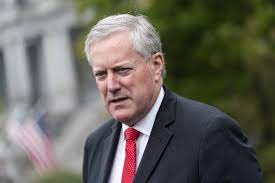
Trump’s Chief of Staff, North Carolina’s Mark Meadows
that there would be mass resignations, including lawyers in the White House Counsel’s Office”, did Meadows back down from some of the more extreme tactics, according to Hutchinson. The House panel also emphasized how personally involved Mr. Meadows was in attempts to pressure Brad Raffensperger, the Georgia secretary of state, over Mr. Trump’s loss there — so much so that Mr. Raffensperger ducked and ignored his phone calls, viewing them as improper.
Ms. Hutchinson told the committee that the White House chief of operations warned that “we had intel reports saying that there could potentially be violence on the 6th”, but Meadows was undeterred. She was on hand when the White House Counsel’s Office told Messrs. Perry, Gaetz, and Gohmert that a plan to create so-called alternative Trump electors to unseat the official electors for Biden was “not sound”, but Meadows gave the go-ahead anyway. He reportedly wrote, “I love it.” in a text exchange with a member of Congress.
In his email exchange with Ginni Thomas, wife of Supreme Court Justice Clarence Thomas (we wrote of this, found here), keeping Trump in power became for Meadows a religious imperative:
“This is a fight of good versus evil… Evil always looks like the victor until the King of Kings triumphs. Do not grow weary in well doing.”
Making unmistakable his willingness to subvert the Constitution was his answer to Jim Jordan’s call for Pence to throw out “all electoral votes that he believes are unconstitutional” to which Meadows replied, “I have pushed for this.”
ROSTERS OF IMPOSTERS
There were sub-plots. Sub-plot #1: Just 15 days after the election, lawyers for the Trump campaign in the battleground states that Trump had lost received a memo outlining a plan to develop alternate pro-Trump slates of electors. The alternates would not contest the official December 14th naming of electors by the states. That would presumably tip the hand of the plot, giving enough time before the final January 6th certification for the strategy to be derailed. The presentation of alternate slates would wait for that final date to suddenly throw the certification into chaos.
Fake elector lists were developed for five states — Arizona, Georgia, Michigan, Nevada and Wisconsin. Following official procedure, they were even submitted to the National Archives.
This was no grass roots movement. It bore all the telltales of centralized organization. “A single glance at the five phony certificates shows that they are nearly identical in format and text, right down to the fonts”, pointed out Philip Rotner, a lawyer who writes at The Bulwark.
A total of 59 individuals from five states signed the documents. “They seem to be a fairly representative sample of Americans with quotidian jobs, nice families, and cute pets — not hardened denizens of the criminal underworld”, Rotner surmised. People who mostly didn’t know that they were being recruited to break the law by committing fraud.
Did Trump know? He issued a statement that he believed it justified to use alternate electors in Congress to challenge the certification, but his statement was a year after the fake electors scheme was exposed.
GHOSTS IN THE MACHINES
Sub-plot #2: Personages such as lawyer Sidney Powell worked to build suspicion of the election with fanciful imaginings that could only be believed by the conspiracy-loving fringe. She proclaimed that voting machines had used software developed in Venezuela jiggered to keep Cesar Chavez in power a dozen years earlier; that the leadership of Dominion Voting Services, which produced the vote-tabulating machines, had ties to George Soros and the left-wing movement antifa; that the Defense Department, which she contacted directly, needed to send a special operations team to Germany to grab CIA director, Gina Haspell, who was there to seize and destroy a computer server farm that had switched votes from Trump to Biden. “This is real! It is not made up”, exclaimed Giuliani. “There’s nobody here that engages in fantasies…You should be more astounded by the fact that our votes are counted in Germany and in Spain!”
A retired army colonel in Texas named Philip Waldron, who had attracted Meadow’s attention with a 28-page Power Point presentation advocating that Trump declare a state of emergency in the wake of the election, came up with the idea of seizing the voting machines in the states Trump had lost. Waldron was in league with retired General Mike Flynn, Trump’s original national security adviser who had been convicted of twice lying to the FBI, his sentence reduced by Attorney General Bill Barr, and his conviction pardoned by Trump. Flynn thought Trump should invoke martial law. He had been on Newsmax to say that Trump could seize the machines and “basically rerun an election in those states”. Actually, Trump had earlier met with Attorney General Bill Barr to ask if he would have the Justice Department impound the machines. Barr had immediately rejected the request.
However outlandish, the notion that the election had been stolen was clearly taken in as belief by the conspiracy-minded. Why other than true belief would the scheme of snatching voting machines have made any sense except confidence that corrupted algorithms would be found in their innards? After all, hadn’t President Trump tweeted that Dominion’s machines had “deleted 2.7 million Trump votes nationwide”? If he said it, it must be true.
To their surprise, Flynn, Patrick Byrne (founder of Overstock.com who had become an avid Trump backer), and Sidney Powell were able to wander into an insecure White House on December 18th without a scheduled meeting. But they caught the president’s eye and were hailed into the Oval Office for what proved to be a raucous meeting. Meadows, White House Counsel Pat Cipollone, and White House aides engaged in what CNN reported as “screaming matches” over Powell’s over the top ideas for overturning the election, Flynn’s push for declaring martial law, and the military commandeering voting machines in battleground states. Aide to Meadows Hutchinson told the committee that White House lawyers threatened to resign if the scheme were adopted.
The meeting went well into the evening with Giuliani contacting the Department of Homeland Security to see if it had the authority to confiscate the machines. Telling the president he would be impeached again and that “we would all end up in prison”, as he later related, Giuliani successfully quashed Trump’s interest in the ploy. Or so it seemed. In documents handed over by the National Archives to the House select committee was a draft executive order for the defense secretary to have the voting machines seized. Another would emerge giving Homeland Security the authority it lacked. The orders were never signed nor executed.
FIRE THE ATTORNEY GENERAL
Sub-plot #3: Trump and Meadows had made repeated attempts to press the Justice Department for help in overturning the election when in late December, Representative Scott Perry of Pennsylvania put Meadows in contact with a high official at Justice, Jeffrey Clark, who had been promoting claims of voter fraud.
Clark had written a letter that he proposed to send to Georgia’s governor, house speaker, and senate president that began with the lie that the DOJ was conducting an investigation of “various irregularities in the 2020 election” and that “the Georgia General Assembly should convene in special session” to look into irregularities in that state. The plan was to send the letter, an implicit threat, to all states narrowly lost by Trump.
“That letter that this guy wants to send — that letter is a murder-suicide pact,” Pat Cipollone told Trump. “It’s going to damage everyone who touches it. And we should have nothing to do with that letter. I don’t ever want to see that letter again.”
Neither Acting Attorney General Jeffery Rosen nor his second in command Richard Donoghue would co-sign the letter, which quashed its sending. But that was a firing offense for Trump, who decided to replace Rosen with Clark. He backed off when he heard that firing Rosen would cause others at Justice to resign en masse.
Clark would invoke the Fifth Amendment more than 100 times when he spoke to the January 6 committee in February. Perry refused to comply, tweeting that the committee is “illegitimate, and not duly constituted under the rules of the House of Representatives”.
DENOUMENT
It could be argued that, to this point, Donald Trump was either not involved in the back and forth between the conspirators or that nothing came of various schemes as they were discarded one by one. That would change in the final few days before the 6th when the key proponents of keeping Trump in power settled on a plan outlined by lawyer John Eastman.
In our goal of documenting the most serious challenge to the nation’s democracy (the Civil War almost split the country in two, but an election went on in its midst), we will spin out that final chapter as the House Select Committee’s public hearings, scheduled to begin June 9th, draw near.
May 22 2022 | Posted in
Takeover |
Read More »
< insurrection|30|50|>
That Donald Trump and the circle around him plotted to abort the constitutional transfer of power to steal the election from Joe Biden and give Trump another term as president is indisputable. Less certain is to what extent indictments 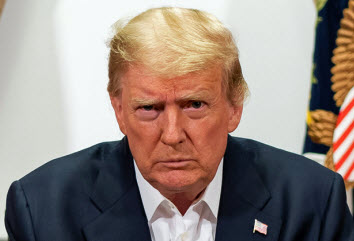
will be brought against the many involved in the conspiracy — a larger contingent than previously realized ranging from Trump’s inner circle and hangers-on to members of Congress — or whether against Trump himself. The congressional select committee investigating the January 6, 2021, riots and Capitol break-in and attempted overthrow of government has interviewed over 800 witnesses to bring to light the full story of that day and the months preceding, and it has concluded that there is enough evidence to bring criminal charges against the former president.
the believers
Two streams of activity converged on January 6 and the congressional committee has explored Trump’s culpability in both.
One traces what Trump’s followers did in reaction to the election. When the results showed Biden as the winner, Trump’s people, primed to believe the election was rigged, made “Stop the Steal” their mantra and have persisted in that theme ever since. Vote recounts ensued in battleground states — multiple recounts in some states — none of which changed the outcome, but organizers made up for that by listing the many sorts of fraudulent ballots they had supposedly encountered. Proof was never forthcoming. Trump had more than once made statements such as, “This election is about great voter fraud, fraud that has never been seen like this before.” Asked for evidence, he would say “soon” but soon never came.
Trump’s own Justice Department confirmed that the 2020 election, more closely safeguarded than any before it owing to Trump-stirred controversy, was free and secure. But Trump voters were not interested in evidence. In Trump’s thrall, they accepted his claim that the election had been stolen. That was what they wanted to hear. They turned a deaf ear to all counterclaims, a mass psychosis 
that had them believing they were saving the country. So they went to Washington, militia groups such as the Proud Boys and Oath Keepers among them, to storm the Capitol.
Nothing has changed the minds of Trump followers. A University of Massachusetts Amherst poll as late as this past December still had 71% of Republicans saying that the 2020 election was illegitimate. Even now, a year and a half after the election, Trump allies in statehouses around the country are pressing their legislatures to pass resolutions to decertify the Electoral College votes submitted to Congress that day in January in the belief that Trump can be reinstated as president.
the conspirators
In parallel is the second cohort: the conspiratorial group that began even before the final vote tally was in to explore how to overturn the loss to Biden.
Just two days after the election, Donald Trump Jr. texted Chief of Staff Mark Meadows that, with Republican majorities in the Senate and legislatures of key states, “It’s very simple, We have multiple paths We control them all.”
This would culminate two months later with the pressure campaign to make Vice President Pence refuse to accept the Electoral College submissions from the battleground states when he presided in Congress to count the votes. Several overheard Trump’s final call to Pence. They could not hear what Pence was saying but Trump’s saying “You’re not tough enough to make the call”, as recalled by persons in the room, made clear that Pence had refused. Even Trump’s daughter saw the wrong. Ivanka said to an aide next to her, “Mike Pence is a good man.”
but will any be brought to account?
The committee will likely refer several of the conspirators to the Justice Department for prosecution. But will the Justice Department, either on its own or in response, follow through with indictments? The DOJ has concentrated on identifying and indicting members of the mob that attacked the Capitol and caused the deaths of Capitol police but not, or so the silence suggests, the planners of the insurrection. Inaction has earned for Attorney General Merrick Garland increasing public anger that Justice may be letting the bad guys off the hook. Is Garland wary of his department seeming too political, all targets being Republicans? What would be more political, though, than not pursuing criminal conduct in deference to politics? And yet we have seen months go by with no response after the select committee referred criminal contempt charges to the DOJ for prosecution of those who ignored subpoenas to testify.
Garland just tapped a high-profile career prosecutor to run the probe of the plot’s leaders, but it is well over a year after the events of January 6 and the new hire as yet has no apparent team.
So if there is to be any justice of perpetrators brought to account, will we stop pretending that no one is above the law by showing that to be true? And most particularly, will charges be brought against the one man who instigated the entirety of the attempt to overthrow the government?
However obvious to the lay person is Trump’s participation and guilt in the insurrection, the legal challenge is to tie together the loose threads to make him the direct cause. There are two avenues being explored to explicitly link Trump to the crimes:
One: Did Trump Incite the Attack on the Capitol?
One can readily see the direct path between the stolen election myth Donald Trump created to the assault on the Capitol. In the summer of 2020 and into the fall, he began laying the groundwork of disbelief in the election should he lose, saying it would be rigged, that only by cheating could the Democrats win, that mail-in ballots would be rife with fraud, that “millions of mail-in ballots will be printed by foreign countries”. It was a deliberate ruse, an imaginary conspiracy conjured to convince his flock that the election was fraudulent. The lack of evidence, the over 60 cases that failed in the courts, the illogic that thousands of fake ballots would somehow be accepted at polling places, nothing would offset the power of his constantly repeated Big Lie.
Among the faithful were the rightwing militants. Asked in the first debate in October with Biden to condemn “white supremacists and militia groups”, Trump had been evasive, but he signaled “Proud Boys, stand back and stand by.” On December 12, thousands had gone to Washington to protest the election for the second time in two months bringing together the Proud Boys, the Oath Keepers, and the 1st Amendment Praetorians. Their president flew over the crowd in Marine One. All three groups would be on hand on January 6.
Three days later, Oath Keeper founder and leader, Stewart Rhodes, posted an open letter to Mr. Trump urging him to invoke the Insurrection Act. The day following, the Three Percenters issued a statement saying their members were “standing by to answer the call from our president.”
Duly primed, they were ready when the call came in the early hours of December 19 when Trump tweeted, “Big protest in D.C. on January 6th … Be there, will be wild!”.
The messaging between militant group members that immediately ensued in response to that tweet, discovered when Justice Department prosecutors began developing cases against militants, has led them and the congressional select committee to the belief that the tweet was the seminal incitement for the riots. What Trump meant was clearly understood by one militant who posted that Trump…
“can’t exactly openly tell you to revolt. This is the closest he’ll ever get.”
The first to be convicted at trial, a Texas oil field worker, had within a day posted to a group chat with members of the Texas Three Percenters:
“Our President will need us. ALL OF US…!!! On January 6th, We the People owe him that debt. He Sacrificed for us and we must pay that debt.”
Flying to Washington was out because of the “battle rattle” of armament he planned to bring, so he said he would drive.
Three days after Trump’s tweet, a gleeful Kelly Meggs, a leader of the Florida Oath Keepers, wrote at Facebook…
“Trump said It’s gonna be wild!!!!!!! It’s gonna be wild!!!!!!!, He wants us to make it WILD that’s what he’s saying. He called us all to the Capitol and wants us to make it wild!!! Sir Yes Sir!!! Gentlemen we are heading to DC.”
The Oath Keepers weren’t keeping it a secret what they planned to do that day:
“Trump has given us marching orders, and, basically if you’re east of the Mississippi you can and should be there…Keep your guns hidden…walk into DC…bring your plate carrier, your flag, radio and charging kits…your trauma kits…If/when it’s time to arm up…180 rounds minimum for main rifle, another 50 for sidearm, per person.”
In a letter, Rhodes wrote that many of the “tens of thousands of patriot Americans” who would head for Washington would stow their “mission-critical gear” outside the city. Filings in court cases say the Oath Keepers had reserved hotel rooms in Arlington, Va. Based there would be three teams of armed militiamen as a “quick reaction force” to rush into D.C. if needed.
An Arizona team member told Rhodes that “Everyone coming has their own technical equipment and knows how to use it.” Chat boards had been abuzz with assault tactics and what gear would be needed. The Proud Boys set up crowd-funding campaigns for travel expenses, “protective gear and communications”.
Rhodes in an interview declared that there would be “a massively bloody revolution” if Biden took office. A Three Percenter member wrote that what would be needed was for “the crowd to drag the traitors out.” A Proud Boys member posted a message that said, “Time to stack those bodies in front of Capitol Hill.” Much of the discussion of potential violence occurred at TheDonald.win, a pro-Trump chat board, such as threats to trap lawmakers in the tunnels of the Capitol. The advice was to “Bring guns. It’s now or never.”
On January 6, Donald Trump looked out over the “hundreds of thousands”, or so he imagined, at the Ellipse that his single tweet had brought to Washington. They were there to make it “wild”, to disrupt the process of certifying the election. He at one point said, “I know that everyone here will soon be marching over to the Capitol building to peacefully and patriotically make your voices heard”and that he would be going with them, and thus establishing that the crowd was there to do a job. “Peacefully” fell away, as did his joining them on the march, when he grew strident near the end of his talk, telling them…
“We’re going to have somebody in there that should not be in there and our country will be destroyed and we’re not going to stand for that…We fight like hell. And if you don’t fight like hell, you’re not going to have a country anymore… Because you’ll never take back our country with weakness. You have to show strength and you have to be strong.”
Politicians always use words like “fight” goes one argument, but that ignores the context of that day — who he was talking to, why they had come, and the mission they thought had been assigned to them. It was a crowd that would indeed fight. A crowd that would seek to “Hang Mike Pence”.
If not a subscriber, sign up below now so as not to miss. And might your friends be interested? Email them this link to the first article above: https://bit.ly/2Nt9aEu
May 11 2022 | Posted in
Takeover |
Read More »







